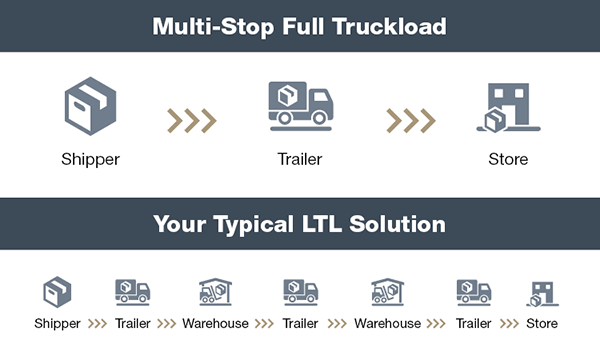As a transportation provider, one of the most common questions we get from our customers and prospects is why do trucking rates change? You’ve probably wondered the same thing yourself a time or two. In this article, we’ll give you an idea as to what factors cause rates to change, how you can avoid getting ripped off and how you can plan for these rate fluctuations as you assess your shipping needs.

As typical consumers, we’re used to prices for products slowly going up with inflation. For example, your favorite old t-shirt that cost you $10 two decades ago would run you $15 today. In reality, it’s worth the same amount as it was back then, but the dollar doesn’t go as far today.
Anyway, economics lesson number one aside, not every industry has the luxury of changing prices with inflation — and the transportation industry is no exception. (Here comes economics lesson number two.) Supply and demand plays a major role in the price you’ll pay as a shipper when it comes time to move a bunch of, let’s say, t-shirts. (Sorry about going on about t-shirts. As I’m writing this, we’ve been stuck in subzero temperatures for about two weeks and I’m just daydreaming about the day I can comfortably wear a t-shirt outside again.)
Let’s go beyond the basics of supply and demand and explain why rates change and how you can find ways to avoid paying more than you have to.
What Impacts Trucking Rates?
Beyond the typical supply and demand, there are two key factors that weigh into what you pay to ship your freight:
- Seasonality: The time of year will always play a role in what you pay. For example, historically rates drop in January and February (after the holidays) because the demand for capacity isn’t nearly as high. Unexpected storms — like snowstorms and hurricanes — also play a part. You will see increased rates and changes in available capacity, depending on where you’re located following a storm.
- Location: Speaking of location, where your facilities are will certainly impact the rate you pay to move your freight. If you are right next to a common freight lane, you’ll benefit with lower costs because trucks are in your area and want to be in your area. On the other end of the spectrum, if you’re in an area with little inbound and/or outbound freight, you’ll pay a premium to get a truck to come out there.
The Pandemic…

Talk about a roller coaster ride when it comes to freight rates. The COVID-19 pandemic has given us all the highs and lows you can expect in the freight market in the last 12 months.
At the onset of the pandemic, when many things shut down, most people weren’t moving freight. Rates hit historical lows and many carriers were taking virtually anything to keep their trucks moving. Another side-effect of that was many trucks and drivers decided the safety risk wasn’t worth the low rates, so they temporarily pulled their trucks off the roads — or shut down for good.
Plus, many driving schools were forced to shut down for a while — and run at limited capacity when they opened up again — leading to fewer drivers entering the field. The pandemic also had many older drivers retiring early, so there’s become an imbalance of new drivers coming in and older drivers leaving the industry.
That’s leading to the current state of rates. Now, many shippers are playing catch-up — or simply moving more than they’re used to because of people’s changing buying habits (think home improvement goods) — and that’s leading to a heavy increase in demand. With the higher demand and less capacity to keep up with it, rates are at historical highs.
How You Can Find Ways to Save on Trucking Rates
The pandemic is (hopefully) a once-in-a-lifetime experience for all of us, but we’ll break down ways you can lower your costs now — and long into the future when things get back to normal.
- Avoid partial truckload moves: If you have the flexibility to wait to move your products until you have enough to fill an entire trailer, it’ll pay off for you. Less-than-truckload (LTL) is a great option in some cases, but you’ll pay less per piece if you can move a full truckload. If you’re doing LTL shipments because you have multiple pickup and drop-off destinations, consider using a multi-stop truckload move instead.

- Have flexible pickup and delivery windows: In some cases, it’s vital to your operation to have products picked up and delivered just in time (JIT). If that’s not the case for you, provide a “window of time” that you’d like your freight picked up and delivered. That will give your transportation provider more flexibility, which in turn gives the driver more flexibility, which can lead to lower rates.
- Work with the right type of transportation provider: Over-the-road (OTR) asset-based carriers generally don’t like taking shorter runs, however, there are regional and local carriers. Another option is working with a trusted freight broker that will have quality relationships with carriers in all kinds of specialties.
Especially if your needs vary, a broker can be a great option to find the right type of equipment for your unique needs, every time. Or, get the best of both worlds and find a transportation provider that has both. In those cases, the asset “sister company” has first right of refusal, but if they don’t fit your industry perfectly or have available capacity, the broker can turn to their trusted carrier network to find the perfect fit.
Why the Right Transportation Partner Makes All the Difference
Do you want a “transactional relationship” or one that lasts a lifetime? There’s no wrong answer to that question, but it will impact which carrier is the best fit for you. If you’re looking for a long-lasting partner, you’re probably not going to find that in the lowest cost carrier. Instead, you want someone with the fleet size and diversity to meet your needs, plus a high service record and someone who will take the time to explain things to you.
I don’t know about you, but I like to know why something is the way it is. I like to tell my customers why the rates are high and what they can expect coming up. Because relationships are so important to some transportation providers, they won’t be afraid to tell you what to expect with rates in the near future — and if you should move your freight now or wait for lower rates. The transaction-based carriers probably won’t be forthright with that information since they’re only worried about booking your load now.
The right transportation partner invests time in educating you on how to get the best and most efficient performance in your supply chain. That’s also information you can pass along to your customers to better educate them. For example, instead of saying rates are high because of the pickup time, you’ll come armed with the knowledge to explain why pickup time impacts rates. Together, you’ll be able to make better shipping and receiving decisions and strengthen your own relationships for the long term.



